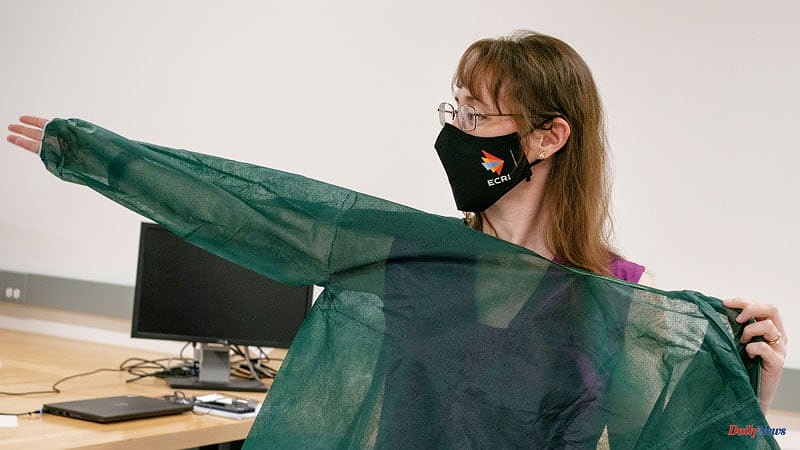Disposable gowns that are designed to absorb bodily fluids have not performed well in laboratory tests. They may also fail safety standards and pose a higher risk of infection for health care workers than they advertise.
Peer-reviewed academic research, published in the midst of the coronavirus pandemic was not widely known. It found that the isolation gowns used in hospitals and intensive care units were too fragile and allowed liquids to seep through the fabric when it was sprayed or splashed.
Elizabeth Easter, co-author of the study, is a University of Kentucky textile expert and spoke highly of the use of thin disposable gowns. Technically, you can see through it.
ECRI Engineering Director Chris Lavanchy said that a similar study is currently underway. ECRI is a non-profit focused on safety in health care. They began testing disposable isolation gowns following anecdotal reports about "blood or other fluids leaking through." KHN was informed by Lavanchy that preliminary tests raised concerns that disposable gowns might not be safe.
Hospital workers use isolation gowns to protect their arms and torso from fluids before they enter the rooms of contagious patients. This prevents fluids from clinging to their clothing and ending up in their eyes. Although germs rarely seep through gowns to infect the wearer, it is possible for them to spread millions of times if they are not used regularly in hospitals.
Karen Haberland puts her hand underneath the see-through fabric in an isolation gown at the ECRI laboratory.
Lavanchy stated that it is an expected principle in infection control that there should be no body fluids getting through. "If liquids do get through, it is very likely that there will be a risk."
Lavanchy refused to give more information about ECRI's findings but stressed that ongoing testing is taking place. The organization is currently in talks with gown manufacturers so that they can question or challenge the findings before the full report's publication, which is expected to be released later in the year. Officials involved in both the academic and ECRI studies did not identify the brands or names of the gowns that were tested. However, they said that the gowns were purchased from the main suppliers to U.S. hospitals.
KHN reached out for comments to three major suppliers of hospital gowns. None of them responded.
As the coronavirus pandemic has raised concerns about infection control in hospitals, and the limits of supply chains for personal protective gear such as gowns, the testing of isolation gowns is necessary. In the first year of the pandemic disposable gowns were scarce, leading some nurses to use trash bags to cover their bodies. Some hospitals also had to rush to buy gowns from foreign suppliers or manufacturers without gown experience. ECRI testing revealed that many of these gowns were not protected at all. This led to a lot of attention being paid to the poor quality control in the gown industry. The organization has since begun testing gowns from traditional suppliers.
Some hospitals may reconsider using reusable isolation gowns due to shortages in supplies and concerns about the quality of disposable gowns. These gowns can be washed about 75 times. Pilot programs and studies have shown that reusable gowns provide at least the same protection, lower costs, and are better for the environment. Reusable gowns were also readily available during the pandemic. This allowed hospitals to avoid shortages and soaring prices.
Inova Health System, located near Washington, D.C., converted two of its hospitals into reusable gowns in 2021 in order to protect itself from supply chain problems. It hopes to add the gowns to its three remaining facilities by the end this year. Officials at Inova stated that Inova had used 3 million disposable gowns per year before the change. This created 213 tons of waste.
Michelle Peninger, Inova assistant vice president for infection prevention and control, said that there was much trial and error. It will all come out in the end.
Chana Luria has been a California nurse for over 30 years and said that she long preferred the washable gowns of the first ten years of her career. She said they felt thicker and safer than the disposable ones. She said that fluids that splashed onto the gowns could slide to the ground, sometimes creating a slip hazard. However, it never got through to her clothes or skin.
Luria stated that disposable gowns are preferred by many nurses because they are cooler and more breathable. However, comfort should always be the priority. Luria stated, "I would prefer to be sweating in Hefty bags and have some form of actual protection." It's known as personal protective equipment. It's useless if it doesn't protect your life.
Isolation gowns can be worn for just minutes, regardless of how they are washed.
All those minutes add up. UCLA Health is a four-hospital hospital chain in Los Angeles that has switched to reusable gowns over ten years. A single liver transplant unit used up to 1,000 disposable gowns per day at UCLA Health, according to Norm Lantz (senior director of general services). Lantz stated that "we were spending millions on gowns." "Then we realized that all the money we spent on gowns was actually filling landfills."
According to the FDA, most isolation gowns can be classified as "level one" gowns. These gowns can be worn in standard medical units or during basic care. Thicker "level two" gowns can be worn in ICUs during blood draws and suturing. Although the FDA recognizes the standards for isolation gowns developed by three organizations, the American National Standards Institute and the Association for the Advancement of Medical Instrumentation (ASTM International), there is no independent verification that gowns comply with these standards.
Nurses Cathleen Martinez and Catherine Luu use reusable isolation gowns at Ronald Reagan UCLA Medical Center Los Angeles. (JOSHUA SUDOCK / UCLA HEALTH).
Isolation gowns are not subject to the same scrutiny as surgical gowns. They are therefore exempted from government review. Gown companies are responsible for quality control.
The recent academic study by Easter and a Florida State University textile-testing expert, found that disposable isolation gowns were far below industry standards. It was published in the American Journal of Infection Control 2021. These tests were conducted in 2018, just before pandemic shortages reduced the quality of gowns.
The researchers tested the ability of the gowns to repel bodily fluids by spraying them with water. They also determined whether the weight of the protective material on the opposite side increased.
According to the study, disposable gowns at level one let through 16.2 grams of liquid on average, which is more than the standard 4.5-gram limit. The average disposable gown for level two was 13.5 grams, but they were expected to leak no more than 1gram.
The FDA did not recognize both levels of disposable gowns as meeting a standard of tensile strength at the time of testing, but it has since been. The gowns should be able to withstand 7 pounds of force. According to the study, level one and level two gowns were able to withstand pressure applied widthwise.
Many brands of reusable gowns passed both the tests with comfortable margins even after being washed 75 times.
Meredith McQuerry (supervisor of Florida State's Textile Testing Lab), co-authored the study. She said that the failures in disposable gowns are a result of standards "not being fully enforced."
She stated that "one hundred percent of this should not be only considered further study." It should alarm the medical profession about PPE concerns.
ECRI has begun a separate study at its Philadelphia laboratory, which will replicate the academic results. ECRI also announced that it will conduct a survey where health care workers can report gown problems. The organization named insufficient disposable gowns as one of the "top 10 health technology risks" for 2022.
Karen Haberland uses a funnel to pour water onto a sample from an isolation dress.
Tim Browne, ECRI vice president for supply chain solutions, stated that alarms started to sound during the initial pandemic because of shortages in supply. In desperate hospitals, gowns of questionable quality were used, often from Chinese suppliers.
ECRI evaluated 34 gown models from non-traditional and foreign suppliers in 2020. According to documents, about half of the gowns failed to meet the required protection level.
Browne stated that there was "more fraudulent product on the market than ever" and that this is what raised concerns from a quality perspective.
Although there were doubts about disposable gowns in 2020, these issues were a reaffirmation for hospitals that had made the switch to reusable options years ago.
Officials from UCLA Health and Carilion Clinic in Virginia, which is a seven-hospital chain, stated that they didn't have any shortages and just had to launder faster to meet pandemic demand.
Hospital groups claimed that they are protected from surge pricing. This can sometimes cause the price of one disposable gown to go up from 80 cents to almost $3.
Lantz stated that UCLA Health has prevented over 1,200 tons waste and is now able to save $450,000 annually after switching its emergency rooms and inpatient units to reusable gowns.
Jim Buchbinder, Carilion Clinic's director of laundry service, stated that reusable gowns saved hospitals around 40 cents per usage even before the pandemic.
Laundry workers prepare Carilion Clinic’s reusable isolation dresses and other linens for washing.
Buchbinder stated, "Fifty cents per gown when we're using 120,000 dresses a week during pandemic -- this is substantial." We had them to use. Carilion didn't have trash bags.












